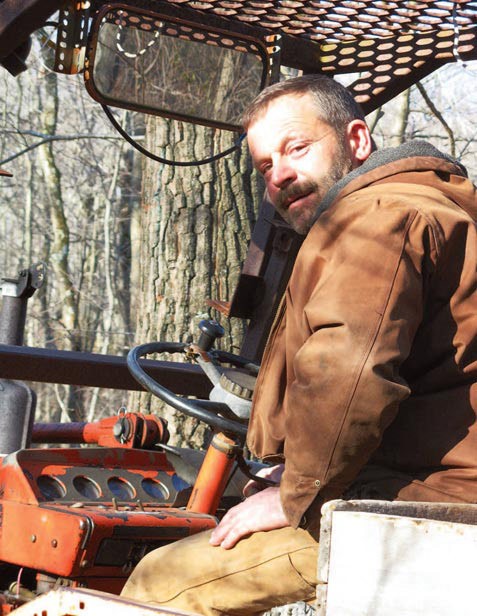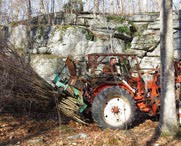Connecticut forester, logger, and all-around woodskeeper Bob Haines abides by two principles: waste not, want not; and take the time to do it right. Haines has an aura of calm thoughtfulness. His clothes emanate that fuelly wood smell of a chainsaw. His hands are pure callus from years of tinkering and grasping.
Haines has lived in central Connecticut all of his life, where he’s worked just about every forest-related job you can think of – including arborist, logger, and forester. Raised in the suburbs, he learned to be handy from his toolmaker dad and from early jobs in a local repair garage. He fell in love with the woods on family camping trips to Northern New England. From the age of 10, he knew he wanted to be a forester.
Haines studied forestry at Unity College in Maine and at the University of Massachusetts in Amherst. After a series of wood procurement and logging supervision jobs for sawmills in central Connecticut in the early 1980s, he set out on his own in 1988. Initially, he bought a wood splitter and used it at log landings to fill his dump truck and sell firewood. Soon afterward, he bought a Belarus 525 tractor with a Farmi winch and a log truck so that he could cut his own logging jobs. Despite daily use for over 20 years and many repairs and modifications, the same equipment serves Haines well to this day.
Despite being a densely populated state, Connecticut remains 60 percent forested. It has a healthy forest products industry that is served by a forest full of sawtimber-sized trees. Roughly 85 percent of the forest is privately owned, two-thirds of it in parcels of less than 100 acres. Many 2- to 5-acre, rural, wooded house lots have been developed in the past 30 years, making the wooded landscape much more suburban than in northern New England.
In response to this fragmented landscape, Haines has tailored his business model to accommodate small, private woodlots. Many forest owners live close to their woodlots and they put a high value on aesthetics and a much lower value on income from their forests. As a result, many are wary of larger-scale logging equipment and are more inclined to accept logging by Haines and his tractor.
Haines has created a solid reputation for clean, neat jobs, saying: “Everyone seems to like tractor logging for its agricultural charm and low impact.” In addition, everyone also likes the chipper and portable sawmill he has added to his quiver of capabilities.
“The landowners want trails, wildlife habitat improvement, and clean work,” said Haines. “I enjoy making trails, building brush piles, providing growing space for mast trees, and keeping my landings and trails smooth and clean.”
Logging in a densely populated area has led to more than one humorous clash of cultures. Once, he was doing a salvage cut in the wake of an infestation of hemlock woolly adelgid. The job was near an informal recreational trail, and Haines had a hemlock tree spin on him and land in the crotch of a nearby oak. Despite his normally reserved nature, he found himself cursing that hemlock with every name in the book, that is, until he turned and noticed an older woman on cross-country skis staring at him, mouth wide open.
“I’ll never forget the look on her face,” said Haines.
In 2000, Haines injured his neck and right shoulder in a car accident. During his recovery, he took a break from sawlogs and firewood and began harvesting witch hazel shrubs for American Distilling, Inc., in his hometown of East Hampton. The main stem and twigs of witch hazel are distilled for their oily extract that contracts tissues (skin, pores, blood vessels). This astringent property was first discovered by Native Americans and then adopted by the colonists. Today the extract is used on the skin in both pharmaceutical and cosmetic products, from acne wash to hemorrhoid cream to mouthwash. It is an essential ingredient in many ‘all-natural’ products. (Witch hazel is also called winterbloom, snapping hazel, spotted alder, and Hamamelis virginiana. See Species in the Spotlight, Autumn 2002.)
When asked what exactly he does, Haines replies; “I cut the shrub stems at ground level in the winter, hand-pile the branches, use the tractor grapple to pull the piles roadside, then chip them into the dump truck. The cut stubs will resprout in the spring to grow another crop in about seven years. I get paid by the ton, and I pay the landowner by the ton.” Haines harvests the main stem and twigs only in the dormant season, as required by the distilling process.
The next step is to truck the chips. Haines hauls directly to the distillery, where his truck is weighed and his load is dumped into an indoor pile of pure hazel chips. The 3-inch wafer chips are then cleaned with blowers and stored in dry, aseptic silos. From here the essential oils are extracted from the chips through a proprietary distillation process utilizing/using purified steam and natural ethyl alcohol. The end product is then stored in 25,000-gallon stainless steel tanks. The leftover woodchip pulp is used for landscape mulch, and the excess heat produced is reclaimed to heat the facility and supply its hot water needs. The entire distilling process takes less than a day and is fully automated.
Bob is one of about a dozen suppliers of witch hazel in southern New England. All of them harvest the shrubs on a parttime basis. Most are loggers, farmers, or tree-service workers who have the equipment and know-how to do this work for supplemental income. A few are second- and third-generation hazel cutters.
During the past ten years, Bob has used his diverse mix of abilities and apparatus to do a variety of jobs. He might be cutting witch hazel one month and firewood another, and custom-cutting native lumber in yet another. When asked about his mix of work, Bob replied, “I like having the ability to do many things. Sometimes I am able to combine a mix of work on one woodlot (logs, firewood, witch hazel, trails, sawing lumber, field reclamation).” Despite the down economy and forest industry, Bob remains optimistic about his ability to adapt to what landowners, society, and the forests need.





Discussion *